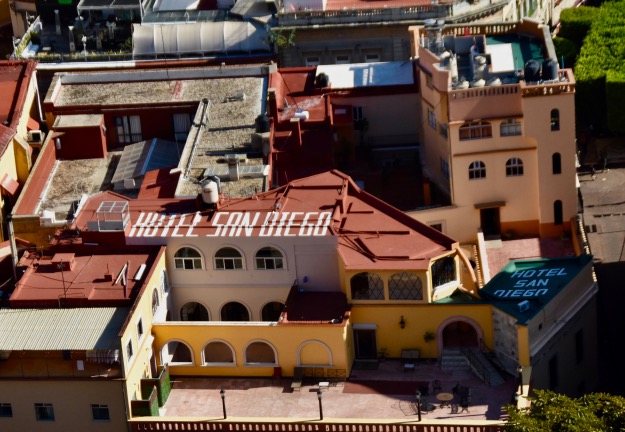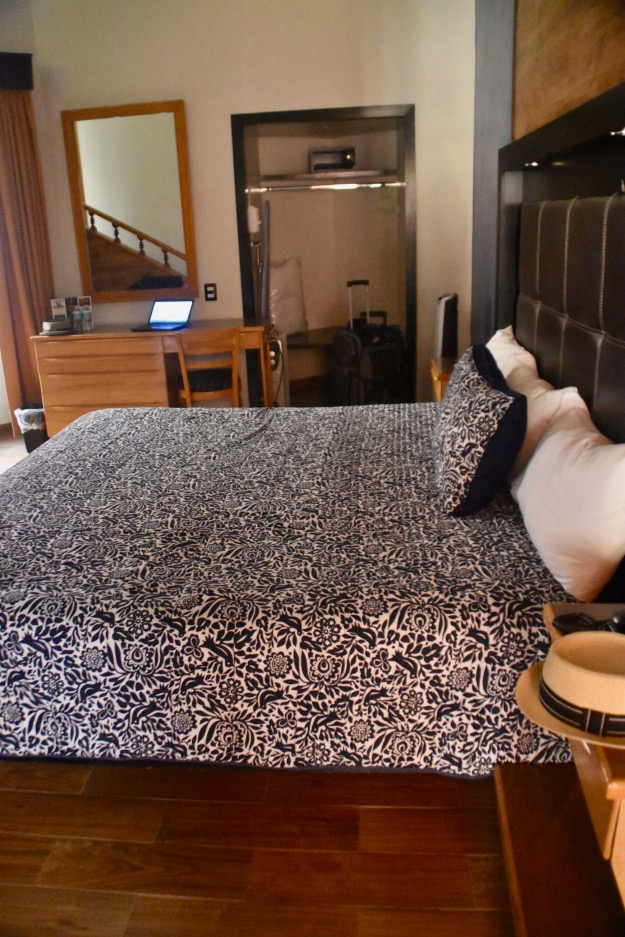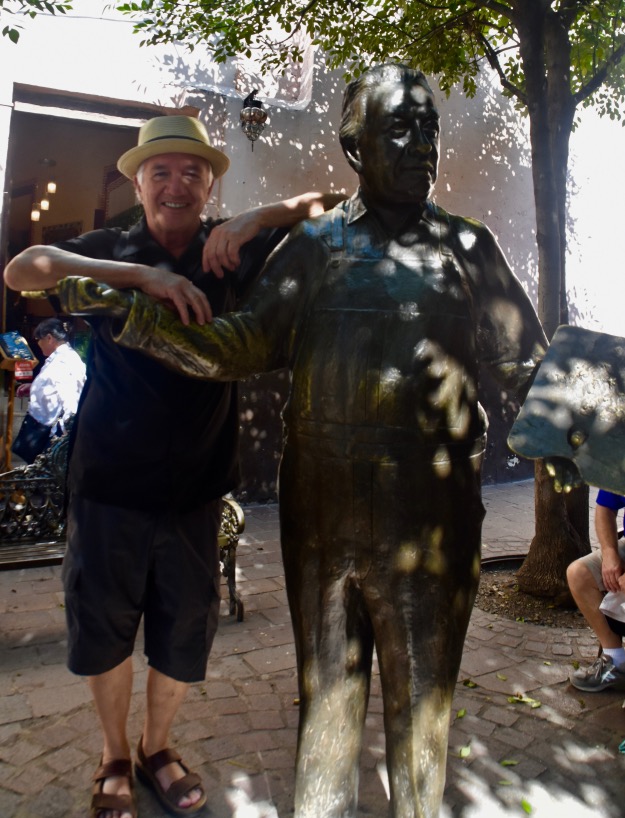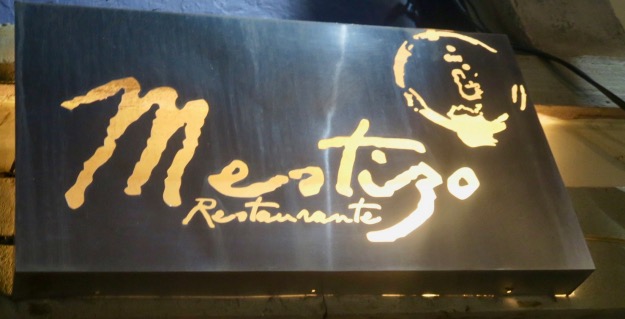If a trip is best measured in memories, well our Central Mexico tours produce many. In his 18th instalment from one of our tours, Dale of The Maritime Explorer shares why he loves this region just so much.

This is my eighteenth post from last year’s inaugural Central Mexico with Victor Romagnali offered by Canadian travel company Adventures Abroad. It was one of the best overall trips Alison and I have ever been on and traveling with Victor always guarantees a great cultural, historical and gustatory experience.
Our last stop was in the very popular (for good reason) small city of San Miguel de Allende where we had the chance to meet up with old friends and share drinks and a great meal at the Casa de Sierra Nevada, one of the best hotels we stayed at on the entire trip.
Today we are travelling the very short distance from San Miguel de Allende to Guanajuato, a city I had never heard of before this trip. Now having spent the better part of two days there, I can say without hesitation that it is a true gem in every way and perhaps my favourite city in Mexico. Let me tell you why.
History of Guanajuato
 Wide Angle of Guanajuato
Wide Angle of Guanajuato
Guanajuato was first and foremost one of the great silver mining cities of the world. I use the word ‘was’ because the silver and gold that was extracted from the hills and valleys of the area has long been mined out, the last mine closing in 1928.
The presence of precious minerals was known to pre-Columbian people of the area and the Aztecs were actively seeking gold and silver for their elites when the Spanish arrived. By 1540 they learned of the earthly riches of the Guanajuato, initially mostly gold and one of the first gold rushes in the world was on. Then they started finding the richest silver deposits on earth.
By the 18th century Guanajuato was the silver mining capital of the world with one mine alone, the Valenciana producing up to two thirds of world production. Anyone who has studied European history will know that in the 17th and 18th centuries Spain was the richest country in the world, entirely because of places like Guanajuato which they exploited ruthlessly.
However, much of the riches from the mines remained in local hands and the city was considered the wealthiest in Mexico right up until the late 19th century. The result is an abundance of baroque architecture that ranks as among the best in the New World and, along with the remnants of the mines, a primary reason the city was named a UNESCO World Heritage Site in 1988. This is how UNESCO describes the uniqueness of Guanajuato.
Founded by the Spanish in the early 16th century, Guanajuato became the world’s leading silver-extraction centre in the 18th century. This past can be seen in its ‘subterranean streets’ and the ‘Boca del Inferno’, a mineshaft that plunges a breathtaking 600 m.
The town’s fine Baroque and neoclassical buildings, resulting from the prosperity of the mines, have influenced buildings throughout central Mexico. The churches of La Compañía and La Valenciana are considered to be among the most beautiful examples of Baroque architecture in Central and South America. Guanajuato was also witness to events which changed the history of the country.
That last sentence is a reference to the Mexican War of Independence. The first major battle of the war took place in Guanajuato at a site we’ll visit later in this post. So the city has great architecture, some very important history and as it turns out is the home to perhaps Mexico’s most famous artist – Diego Rivera. We’ll visit his birthplace. Finally, if this is not enough, we had some of the best meals of the trip here. So let’s get going.
La Valenciana
 San Cayetano Church
San Cayetano Church
The city centre of Guanajuato lies in a valley surrounded by steep hills, many of which are topped with ancient villages that date back to the first mines in the 16th century. One such is La Valenciana, where that famously rich mine was located.
It is our first stop in the area and involves the driver snaking the bus up a road that gets narrower and narrower until it's barely wider than the bus itself, until we reach the town centre and there’s just enough room to get out.
Across the street is a magnificent view of the city of Guanajuato and in front of us the Mexican Churrigueresque facade of San Cayetano church. And before you ask “What the hell does Churrigueresque mean?”, just think of it as a fancy version of Baroque.
It was built by the owner of the mine who was giving thanks to God for personally delivering to him this mountain of riches. The least he could do was build a church and cover the interior with some of the gold from that mine. In the case of the altar of San Cayetano, all that glitters really is gold.
 San Cayetano Gold Altar
San Cayetano Gold Altar
The ceiling of the dome was more appealing to me than the excess of the altar. There is just something about the symmetry of a well constructed cupola seen directly from below that almost mimics a spider’s web and this one captured that look very aptly. I thought about the miners whose toils brought about the wealth that could lead to a construction like this and realized that they were really the flies in the web that were necessary for the spider to survive.
 San Cayetano Church ceiling
San Cayetano Church ceiling
Somehow the driver had gotten the bus turned around and we made our way back down the hillside with some great views of the colourful houses that line the hillsides of Guanajuato, many only accessible by way of long staircases.
 Guanajuato Hillside
Guanajuato Hillside
Like San Miguel de Allende, Guanajuato’s central streets are far too narrow for buses and in many cases, even cars. There is a large parking lot on the outskirts of the city where Victor got us transferred into taxis for the ride to the hotel. Even then we still had to get out and walk the final 100 yards or so. No big deal.
Near the bus parking lot there is this very fine statue dedicated to the many thousands of miners who made the ultimate sacrifice while unearthing the riches of the area.
 Miner’s Monument
Miner’s Monument
The Hotel San Diego
 Hotel San Diego
Hotel San Diego
Our accommodations in Guanajuato were at the venerable Hotel San Diego which could not have been more centrally located, literally right beside the church of the same name and 100 yards from one of the most famous buildings in the city, the Teatro Juarez.
 Hotel San Diego Lobby
Hotel San Diego Lobby
In keeping with some of major historical events that occurred in Guanajuato the hotel lobby has a series of very good murals depicting some of these events, including this one which I believe shows the Jesuit priest and revolutionary Miguel Hidalgo confronting Spanish troops in the city in 1810. Much more about Hidalgo later in this post.
 Hotel San Diego Mural
Hotel San Diego Mural
The rooms at the Hotel San Diego are more than adequate, but certainly not in the luxury category of the previous night’s stay in San Miguel de Allende.
 Room 201, Hotel San Diego
Room 201, Hotel San Diego
One thing we really enjoyed about this hotel was the second story Italian restaurant with tables on balconies that looked out over the plaza below which was alive with festivities. We had a very nice meal here at a great price.
 Dining Over the Plaza
Dining Over the Plaza
After dinner we went for a stroll and soon discovered that in addition to everything else Guanajuato has going for it, it is also a university town with all the vibrancy and youthfulness associated with places of higher learning. We came across this statue of a troubadour just outside the Church of San Diego and started noticing numbers of students being led by fellows dressed exactly like this statue.
 Callejoneadas Statue
Callejoneadas Statue
Turns out they are part of a tradition that started in Guanajuato in the early 1960’s called callejoneadas, literally ‘alley walks’, whereby students dressed in costume playing instruments, singing, dancing and drinking lead groups through the narrow alleyways of the city. The best way to understand it is to watch this short video.
Along with many folk traditions, even newer ones like the callejoneadas, you can now join groups specifically aimed at tourists who want to participate in the evening fun. They mostly start near the steps of the Teatro Juarez where you can do as we did, just sit there and listen to the mariachi bands or sing along with them.
The one thing you don’t see in these two videos is automobiles which is another reason Guanajuato is so popular. It has one of the largest pedestrian only areas in the country and as Martha Stewart would say, “That’s a good thing.” With that it’s time to hit the sack because tomorrow is a full day. We do so under the aegis of El Pipila who looks out over the city. We’ll visit him tomorrow as well.
 El Pipila statue at night
El Pipila statue at night
A Walking Tour of Guanajuato
There is a lot to see in Guanajuato and today we’ll be led on a walking tour with local guide Gabriel who was one of the best we had on the entire tour. The starting point is the tiny funicular that climbs its way up to the statue of El Pipila and a great look out point over the city. Each car holds only five passengers so it takes a few trips to get everybody up.
 Guanajuato funicular
Guanajuato funicular
So who is El Pipila which translates into ‘the turkey’? He was a real character, Juan Martinez who was born with deformities that gave him a strange walking gait that people derisively likened to that of a turkey and thus his pejorative nickname.
During the first real encounter between rebellious Mexican forces and the Spanish troops, the Spanish and their supporters locked themselves inside the city’s huge granary. It turned out to be a great defensive position from which they could pick off anyone who tried to break in the wooden door that was the only entrance to the building.
Along comes El Pipila who has attained great strength while working underground in the mines. He straps a large flat rock to his back which blocks the bullets and arrows from above and makes his way to the door with a bucket of tar with which he coats the door and lights it on fire. The Spaniards are screwed, but more about that when we visit the granary.
 El Pipila monument
El Pipila monument
It’s an impressive statue done in the Socialist Realist style favoured by left wing revolutionaries. The inscription translates as “There are still other buildings to burn.” and metaphorically nothing could have been more true as between 1810 and 1821 almost half a million Mexicans would die before Spain ceded its independence. Compare that to the 6,800 Americans who died fighting for their independence.
This is the view from El Pipila. Pretty nice, eh?
 Guanajuato from Pipila
Guanajuato from Pipila
Our next stop was the Church of San Diego which has one of the most ghastly versions of Christ I have yet to come across.
 San Diego Dome with El Pipila
San Diego Dome with El Pipila
Usually I wouldn’t include a picture as poor as this one, (shooting through glass inside a dark building is always problematic), but the subject was too important to leave out. This is a replica of the fallen Christ made entirely from real human body parts. You can see the humerus sticking out of the skin. I kid you not.
 San Diego Jesus Made of Real Body Parts
San Diego Jesus Made of Real Body Parts
Right beside the church is the very impressive Teatro Juarez where we sat on the steps last night and enjoyed the strolling callejoneadas and the mariachi bands.
 Teatro Juarez
Teatro Juarez
From here we made our way to the lovely Plaza de la Paz and headed into the university district on our way to the Diego Rivera house.
 Plaza de la Paz
Plaza de la Paz
 University of Guanajuato
University of Guanajuato
This is a typical Guanajuato street in the area near where the famed muralist was born.
 Typical Guanajuato street
Typical Guanajuato street
I can tell we’re getting close because Diego is there in person, hiding in the shade, but I caught up to him.
 With Diego Rivera
With Diego Rivera
And that’s the house where Diego Rivera was born. Not exactly a dump for a painter who championed the freedom of the masses.
 Diego Rivera House
Diego Rivera House
I am a big fan of Rivera’s artwork so I was a bit disappointed at how little of his mainstream work was on display here. However, I did really enjoy this mosaic of Rivera and Frida Kahlo.
 Rivera-Kahlo Mosaic
Rivera-Kahlo Mosaic
The house is three stories high with a central atrium. That’s our guide Gabriel in blue explaining some of the more notable features of the house including the actual bed on which Rivera came into the world.
 Adventures Abroad guide Gabriel in Rivera House
Adventures Abroad guide Gabriel in Rivera House
By now it was lunch time and I settled on one of Guanajuato’s local specialties, enchiladas mineras, which was prepared for miner’s by their wives as a hearty meal at the end of the day. What makes these enchiladas different is the inclusion of potatoes and carrots to the cheese filled tortillas, but always on top of and not inside the enchilada.
Frankly, it wasn’t my favourite local Mexican dish on this trip. I like potatoes and carrots, but not as part of an enchilada. Maybe if I’d spent the day toiling underground with a pick axe I might have a different opinion.
 Enchiliadas Mineras
Enchiliadas Mineras
After lunch the group reconvened and we headed for the Mercado Hidalgo which is huge.
 Mercado Hidalgo market Guanajuato
Mercado Hidalgo market Guanajuato
If you need chiles
 Chilis for sale at the Mercado Hidalgo
Chilis for sale at the Mercado Hidalgo
or a piñata, this is the place to go.
 Pinatas for sale at Mercado Hidalgo
Pinatas for sale at Mercado Hidalgo
Just on the other side of the market we arrived at one of the most famous buildings in Mexico, the Alhóndiga de Granaditas which I mentioned briefly earlier when talking about the murals in the Hotel San Diego. It's a huge, almost perfectly square building completed in 1809 to act as the regions granary. That sounds pretty dull.
Then in 1810 the War for Mexican Independence broke out in the nearby town of Dolores when Miguel Hidalgo y Costilla uttered his famous ‘Grito de Dolores’ or Cry of Dolores, which was the Mexican equivalent of ‘The shot heard round the world.’ Soon this entire area of Mexico was up in arms with Hidalgo leading an army into Guanajuato from San Miguel.
The Spanish soldiers, city elite and Spanish sympathizers locked themselves inside the granary hoping to hold our until reinforcements arrived. However, as we know, El Pipina had different ideas when he successfully lit the entrance door on fire which allowed the insurgents to storm the granary, in a manner reminiscent of the beginning of the French Revolution with the fall of the Bastille. Here’s where things started to go off the rails. The rebels, despite being led by a priest slaughtered everyone inside and then pillaged the entire city.
 Alhondigas de Granaditas
Alhondigas de Granaditas
Unfortunately for Hidalgo and one of his associates in these early stages of the war, Ignacio Allende who we learned of in San Miguel, the revolution petered out when the rebels balked at attacking Mexico City. Hidalgo and Allende fled into exile, but were caught, shot and beheaded.
These heads, along with those of Juan Aldama and José Jimenéz, were each placed at the four corners of the granary and stayed there for the entire duration of the war. With that in mind, lets visit this place with such grisly history starting with the corner where Hidalgo’s head was displayed.
 Hidalgo’s Head Space
Hidalgo’s Head Space
Inside, even though it’s well past the Day of the Dead, there is still a giant Katrina dominating the inner courtyard. Somehow seems appropriate.
 Katrina in the Granary
Katrina in the Granary
The main reason to see the interior of the granary is to see the murals by José Chávez Morado depicting the events that took place here. Here are the mestizos breaking through the door armed and crazed for blood.
 Alhondigas de Granaditas granary mural
Alhondigas de Granaditas granary mural
And here’s how it ended up.
 Hidalgo’s Head Mural
Hidalgo’s Head Mural
By now we had done a lot of walking and it was a fair distance back to the hotel, but Gabriel knew a shortcut. Instead of going up and down the winding streets, we would go in almost a straight line go underneath them.
I have saved the most unique thing about Guanajuato to almost the last. The earth beneath the city is literally honeycombed with old mine shafts and connecting passageways that are now used as highways and walkways to get around faster and keep traffic off the streets of the old city centre.
 Guanajuato Tunnel
Guanajuato Tunnel
In some places the tunnels are completely underground like the photo above and in others partially open aired like the photo below.
 In the Tunnels under Guanajuato
In the Tunnels under Guanajuato
In yet others there are houses literally hanging over the sides of the old mine workings. Boy, that looks really stable doesn’t it?
 Houses over the Tunnels of Guanajuato
Houses over the Tunnels of Guanajuato
In far less time than it would have taken to get there walking above ground we arrived back at the hotel via the tunnels.
We had had a great day exploring Guanajuato, but Victor had one final pleasant surprise in store for us.
Mestizo
 Mestizo Sign
Mestizo Sign
Mestizo is a very small restaurant located in one of the older houses on one of the narrow streets of Guanajuato.
It’s interior is bright and welcoming with interesting ceramics and artwork. I’m not sure, but I think Victor had reserved the place just for us, because I didn’t see anybody else there when we arrived or come in while we were there. I do know that he brought the chef/owner around to greet each table and discuss that evening’s menu.
 Mestizo restaurant interior
Mestizo restaurant interior
In a word, it was one of the very best meals of a trip that had too many to keep track of. This mushroom soup was simply incredible with a flavour unlike any I’ve ever tasted.
 Mushroom Soup, Mestizo
Mushroom Soup, Mestizo
I absolutely am addicted to good ceviche and make it home a lot. This was the chef’s own creation and it too was a knock your socks off taste experience.
 Ceviche at Mestizo
Ceviche at Mestizo
For a main, Alison had this very simple chicken breast in a reduction which was as juicy and properly cooked as a chicken breast can be, something that’s a lot harder for some places to accomplish than you would think.
 Chicken Breast a la Mestizo
Chicken Breast a la Mestizo
I usually don’t order steak in anything but a steak house, but the chef was effusive about this beef tenderloin and he had a right to be. Simply amazing taste and flavour in another cut of meat that is so lean it can easily be ruined.
 Beef Tenderloin a la Mestizo
Beef Tenderloin a la Mestizo
We all walked back to the hotel tired, but pleasantly full and thankful that Victor has included this incredible Mexican city on his itinerary.
Next up, yet another UNESCO World Heritage city – Morelia. Hope you help us explore it.
Many thanks again to Dale of The Maritime Explorer for allowing us to share his words and photos.
Central America is a popular travel destination. Check out our tours of Central America, or our Mexico sightseeing tours.
If you've enjoyed this story about our Mexico tours, you should read our other Mexico travel blog posts!